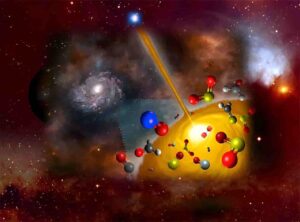
The provenance of oxygen (O2) has been linked to the early Earth’s atmospheric and biological evolution. A permanent rise to appreciable concentrations of O2 in the atmosphere, known as the “Great Oxidation Event (GOE),” was estimated to have occurred at around 2.4 billion years ago. However, the cause of the GOE still remains unclear.
Besides the biogenic processes leading to O2 production, the widely accepted abiotic O2 production is through photolysis of carbon dioxide (CO2) and water molecules (H2O).
Now, a research group led by Prof. Yuan Kaijun and Prof. Yang Xueming from the Dalian Institute of Chemical Physics (DICP) of the Chinese Academy of Sciences has reported oxygen production from vacuum ultraviolet photodissociation of sulfur dioxide (SO2) using the Dalian Coherent Light Source. Their findings were published in Chemical Science on Aug. 1.
“Our experimental results revealed a direct dissociation channel yielding S(1D) + O2 products from vacuum ultraviolet (VUV) photodissociation of SO2 in the wavelength range between 120 and 160 nm,” said Prof. Yuan.
Geological evidences have identified the strong activity of SO2 photochemistry during the Earth’s late Archaean eon, which linked to the origin of the sulfur mass independent fractionation in ancient rocks. But its role in the formation of molecular oxygen is ignored.
The quantitative determination demonstrated that O2 production was an important channel from SO2 VUV photodissociation, with a branching ratio of around 30% at the H Lyman-a wavelength (121.6 nm).
The relatively large amounts of SO2 emitted from volcanic eruptions in the Earth’s late Archaean eon imply that VUV photodissociation of SO2 could have provided a crucial additional source term in the O2 budget in Earth’s primitive atmosphere. Therefore, this event may have led to transient O2 accumulation and could be one possible cause of the GOE.
Reference:
Yao Chang et al, Vacuum ultraviolet photodissociation of sulfur dioxide and its implications for oxygen production in the early Earth’s atmosphere, Chemical Science (2023). DOI: 10.1039/D3SC03328G
Note: The above post is reprinted from materials provided by Li Yuan, Chinese Academy of Sciences.









